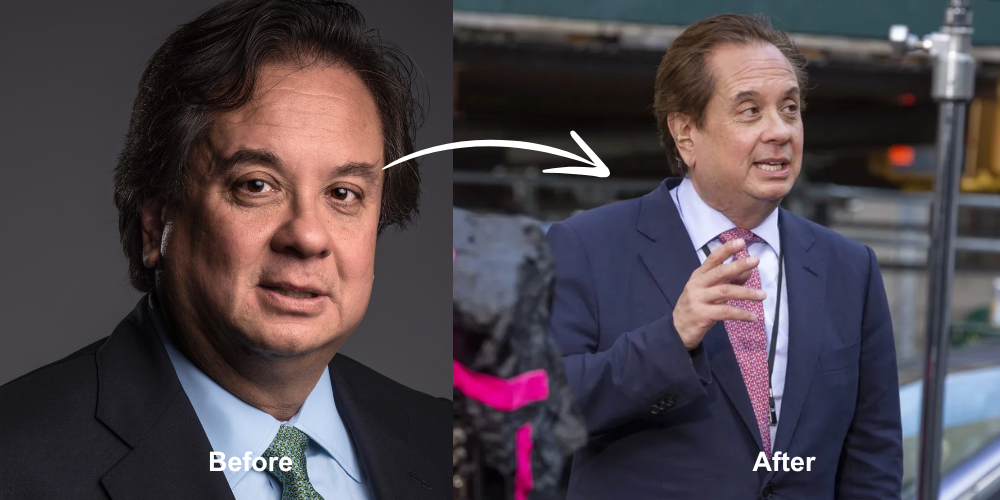Introduction to George Conway’s Weight Loss Journey
When George Conway lost 80 pounds, he started appearing on various media platforms. He was known as a sharp lawyer and political commentator, often speaking on panel shows and openly criticizing Donald Trump. However, it wasn’t just his words that got attention—his body transformation also became a topic of discussion. Once a 300-pound man in formal suits, his shrinking frame was closely followed by the media.
George Conway’s weight loss journey is a story of dedication, discipline, and positive lifestyle changes. His transformation became an example for many people, proving that significant weight loss is possible with effort. The public didn’t just focus on his political views; they were also fascinated by his physical change. His journey resonated with many, inspiring those looking for similar success in their own health and fitness.
His experience highlights what it means to lose or manage weight while constantly being in the public eye. The combination of personal struggle and public interest made his story even more compelling. This article explores the reasons behind his weight loss, the steps he took, and how it has affected his personal and professional life.
Reasons behind George Conway’s weight loss
His decision to lose weight was driven by both personal and practical reasons. Like others who embark on a weight loss journey, he had multiple motivations pushing him forward.
1. Health concerns
One of the biggest reasons for his weight loss was his health. Being overweight increases the risk of conditions like heart disease, diabetes, and joint issues. Conway realized he needed to take action before facing serious health problems. Making a lifestyle change became necessary for his well-being.
2. Career and public image
As a lawyer and media personality, Conway’s career required him to stay sharp and energetic. He needed to be physically and mentally active, especially when appearing on TV. Looking and feeling good also played a role in boosting his confidence and maintaining his professional image.
3. Family and longevity
Another important reason for his weight loss was his family. He wanted to stay healthy and be present for his loved ones for years to come. Making better health choices was a way to ensure he could continue supporting his family without health complications.
4. Public influence
Being a public figure, Conway understood that his transformation could inspire others. Knowing that people were watching his journey motivated him to maintain good habits. His success showed that weight loss is achievable even with a demanding and high-profile lifestyle.
Understanding these motivations helps explain why Conway was so determined to make a change. His journey was not just about looking different but about improving his quality of life and achieving personal and professional goals.
Changes in diet and lifestyle
A key factor in Conway’s weight loss was his diet. He didn’t simply eat less—he made smarter choices about what he consumed. Sustainable weight loss requires attention to food intake, so he adjusted his meals to support his goals.
Instead of eating unhealthy foods, he focused on a balanced diet that helped him stay energized while losing weight. He cut back on processed foods and prioritized nutrition, ensuring he was eating what his body truly needed.
Regular exercise likely played a role as well. Losing weight isn’t just about diet—it also involves staying active. Whether through walking, running, or other forms of physical activity, movement helps burn calories and maintain fitness.
George Conway’s weight loss journey stands as an example of how dedication and commitment can lead to a healthier life. His transformation shows that anyone, regardless of their starting point, can make meaningful changes with the right mindset and effort.
Eating the right foods for health and weight loss
George Conway changed his eating habits by focusing on foods that gave his body energy and kept him full. He made smart food choices, making sure to eat a balanced diet with plenty of nutrients.
1. Lean proteins
Conway included lean meats like chicken, turkey, and fish in his meals. He also ate plant-based proteins, which helped build and maintain muscle without adding too many extra calories.
2. Whole grains
Instead of eating refined carbohydrates like white bread and pasta, he switched to whole grains. This helped him stay energized throughout the day and get more fiber, which is important for digestion and feeling full longer.
3. Fruits and vegetables
By increasing his intake of fresh fruits and vegetables, Conway made sure he was getting essential vitamins and minerals. These foods are low in calories but packed with nutrients that support overall health and metabolism.
4. Portion control and mindful eating
He didn’t stop eating his favorite foods, but he learned to control portion sizes. Eating smaller portions helped him lower his calorie intake while still enjoying a variety of meals. He also practiced mindful eating—slowing down, listening to his body’s hunger cues, and stopping when he felt full.
4. Scheduled meals
To avoid unhealthy snacking and overeating, he planned his meals at regular times. This helped him maintain stable blood sugar levels and reduce cravings.
5. Avoiding processed and high-calorie foods
Conway cut down on processed foods and high-calorie snacks. He replaced junk food with whole food snacks like nuts, seeds, and yogurt, which were healthier and kept him satisfied longer.
6. Reducing sugar and unhealthy fats
He limited sugary foods and unhealthy fats, which helped him reduce calories and improve overall health. This change also had positive effects on cholesterol and blood sugar levels.
7. Staying hydrated
Drinking plenty of water was another key part of his diet. He stayed well-hydrated throughout the day, which helped with digestion and prevented overeating, since thirst is sometimes mistaken for hunger.
Through these changes, Conway followed a balanced and healthy approach to eating, which helped him lose weight and keep it off.
8. Adding exercise to the routine
Aside from diet, Conway also became more active. He included both cardio exercises and strength training to improve his fitness and help with weight loss.
Aerobic exercise
He did activities like walking, jogging, cycling, and swimming. These workouts helped burn calories and strengthen his heart and lungs.
Strength training
To build muscle and tone his body, he included weightlifting and bodyweight exercises in his routine. Gaining muscle also helped him burn more calories, even when resting.
Staying active in daily life
Conway found simple ways to move more during the day instead of treating exercise as a chore.
Walking instead of driving – He chose to walk short distances rather than taking his car.
Taking the stairs – Instead of using elevators, he took the stairs whenever possible.
Flexible workouts – He adjusted his workouts to fit his daily schedule and energy levels.
By making exercise a regular part of his lifestyle, Conway improved his fitness and maintained his weight loss successfully.
Adding variety to workouts
To keep exercise from getting boring, Conway mixed up his workouts. On lighter days, he did activities like yoga or pilates to help him relax and reduce stress. This allowed him to push harder when he went to the gym.
Balancing rest days
Just like with his workouts, he made sure to take breaks in other areas of life too. He spent more time playing with his kids, engaging in fun and creative activities. This helped him bond with his family while also giving him a healthy way to manage stress.
Adjusting workouts for a busy Schedule
When his workdays got too packed, he didn’t skip exercise entirely. Instead, he shortened his workouts and did high-intensity interval training (HIIT). These short but intense workouts helped him stay fit without taking up too much time.
Working with a trainer
Conway worked with a personal trainer, which gave him structure and motivation. Having scheduled training sessions kept him accountable, ensuring that he stayed consistent with his workouts.
Personalized training
His trainer adjusted his workouts as he got stronger, making sure they were always challenging but not too difficult. This kept him progressing without feeling overwhelmed.
Staying motivated
On days when he felt low on energy or frustrated, regular check-ins with his trainer helped him stay on track. The extra support made it easier to keep going.
By following a structured plan and increasing his overall activity, Conway built a strong foundation for weight loss and a healthier body.
Professional guidance in his weight loss
Expert advice played a key role in Conway’s weight loss. He needed professionals to guide him through healthy eating and exercise while making sure his approach was sustainable.
Nutrition support
To make sure his diet was both effective and healthy, he worked with a nutritionist or dietitian. They helped him create a meal plan that met his needs while providing all the necessary nutrients.
Custom meal plans
His diet was carefully designed based on his calorie needs, daily routine, and food preferences. This made it easier for him to stick to the plan long-term without feeling deprived.
Adjusting the diet over time
As he lost weight, his body’s needs changed. His dietitian checked in regularly to make sure his eating plan stayed effective and balanced. This helped him avoid problems like vitamin deficiencies or feeling tired from dieting.
Fitness coaching
Along with diet, regular exercise was a key part of his weight loss. A fitness trainer helped him create a safe and effective workout routine.
Exercise plan
His trainer built a workout program that included cardio, strength training, and flexibility exercises. This helped him burn fat while keeping his muscles strong.
Preventing injuries
With a trainer guiding him, he learned the correct way to exercise, lowering the risk of injuries. If he had any minor physical issues, his workouts were adjusted to keep him safe.
Medical supervision
Since major weight loss can affect health, doctors likely monitored Conway’s progress. They checked his overall health and adjusted his plan as needed.
1. Health check-ups
Regular medical exams helped track how his weight loss was affecting his body. If any health concerns appeared, his doctor made changes to his diet or exercise routine.
2. Addressing health issues
If he had any medical conditions related to his weight, like high blood pressure or joint pain, doctors provided treatments and lifestyle changes to manage them.
Mental health support
Losing weight isn’t just a physical challenge—it’s also emotional. A mental health professional may have helped him deal with the ups and downs of the process, ensuring he stayed motivated and focused.
1. Managing stress
Because of his health issues and being in the public eye, managing stress was very important for Conway. A psychologist helped him handle the pressure while keeping him focused on his health goals.
2. Changing habits
Counselling or therapy helped him build better eating and exercise habits. It also encouraged a positive attitude toward food and his body, making it easier to maintain his progress.
By working with both medical professionals and AI-based health tools, Conway was able to take care of his diet, exercise, and mental well-being. This approach was key to not only losing weight but also living a healthier life long-term.
Facing challenges and setbacks
Like anyone making a big life change, Conway faced difficulties along the way. However, he stayed committed to his health goals and found ways to overcome obstacles.
1. Sticking to a healthy diet
One of the biggest challenges in weight loss is avoiding unhealthy food choices.
Planning Ahead: Conway prepared his meals in advance, so he always had healthy options available. This helped him avoid last-minute, unhealthy choices.
He also practiced mindful eating, paying close attention to his hunger before, during, and after meals. Yoga and meditation helped him recognize when he was full, allowing him to eat less while still enjoying his food.
2. Balancing a busy life
With a demanding career, finding time to exercise and eat well wasn’t easy.
Fast but Effective Workouts: To make the most of his time, Conway likely used high-intensity interval training (HIIT), which is known to burn fat and improve fitness in short sessions.
Meal Prep and Delivery Services: To save time, he used meal prep strategies or healthy meal delivery services, ensuring he always had nutritious food available.
Overcoming weight loss plateaus
At times, his weight loss slowed down, which can be discouraging.
Adjusting Diet and Exercise: When progress stalled, Conway worked with his nutritionist and trainer to make changes, such as trying new workouts or reducing calorie intake.
He also looked beyond the scale for progress—things like having more energy, feeling fitter, or noticing clothes fitting better kept him motivated.
Dealing with public scrutiny
Being in the public eye added extra pressure, as people constantly commented on his changes.
Building Confidence: He learned to ignore unnecessary criticism and focus on his personal journey. This helped protect his mental and emotional well-being.
Support from loved ones
Getting encouragement from family, friends, and others who understood his struggles played a huge role in his success.
Mental health and emotional strength
Losing weight isn’t just physical—it also has emotional challenges.
- Professional Support: Talking to a therapist or counsellor helped Conway address deeper psychological issues that may have contributed to unhealthy habits.
- Self-Kindness and Resilience: He learned to be patient with himself, accept setbacks, and keep going. This mindset kept him motivated and helped him find meaning in his journey.
By following these strategies, Conway stayed on track and built a healthier, more balanced life.
Long-term weight control and lifestyle changes
Losing weight quickly was just the beginning for George Conway. The real challenge was keeping the weight off for months and years. Many people say that long-term success comes from making lasting lifestyle changes and carefully managing their habits. Conway’s approach focused on a balanced and practical way to stay healthy over time.
Shifting to a maintenance mindset
Instead of just worrying about food and weight, he focused on long-term lifestyle changes. Rather than following short-term diets or fitness trends, he made lasting improvements to his daily routine.
Eating a balanced diet
To avoid regaining weight, he stuck to a diet that included all necessary nutrients. He likely continued working with nutrition experts to adjust his meals based on changes in his life, such as a new job or other responsibilities. This helped him keep his diet enjoyable and healthy.
Staying active
Exercise became part of his regular routine, not just something to lose weight. Activities like walking, biking, or swimming helped him stay fit, improve his mood, and support his overall health.
Tracking progress and making adjustments
Keeping the weight off required regular check-ins and adjustments to his plan.
- Health check-ups: He met with doctors regularly to track his progress and address any health concerns before they led to weight gain.
- Updating diet and workouts: He adjusted his meals and exercise routines based on how effective they were and how he felt.
- Mental health support: Staying healthy required emotional strength. Talking to professionals helped him manage stress and the pressures of living in the public eye.
Managing stress and relationships
Stress and difficult relationships can make it hard to stay on track. Learning stress management techniques helped him avoid emotional eating and stay focused on his goals. Having supportive people—friends, family, or even professionals—played a big role in helping him stay motivated.
Using new habits and technology
Health-related technology made it easier to track progress and stay motivated.
- Fitness apps and devices: Smart scales, fitness trackers, and health apps helped him stay on course by providing feedback and reminders.
- Learning and adapting: Keeping up with new health research helped him try new strategies or supplements that could support his long-term health.
Encouraging others and sharing his journey
By talking about his own experience, he not only motivated himself but also inspired others who wanted to maintain a healthy weight.
- Speaking out: He shared his challenges and how he overcame them, helping others learn from his journey.
- Setting an example: By following smart habits in his daily life, he showed that long-term health is possible with the right approach.
This way, he didn’t just keep the weight off—he also improved his overall health and created a lifestyle he could maintain for years.
FAQs
1. What made George Conway to take decision about losing weight?
While the exact reason isn’t known, he may have wanted to improve his health and feel more energetic. Like many people, he may have had unhealthy habits and wanted to make a positive change.
2. What kind of diet did he follow?
Although his exact diet hasn’t been shared, most effective weight loss plans include eating fewer calories while focusing on fruits, vegetables, lean proteins, and whole grains. Many people also work with a nutritionist to make sure they get all the nutrients they need.
3. Did he get professional help?
It’s likely that he worked with a nutritionist, personal trainer, or doctor to create a safe and effective weight loss plan. Experts can help with diet, exercise, and overall health management.
4. How much weight did George Conway lose?
The exact number is unknown, but according to photos and public appearances, shows he lost a noteworthy amount of weight.
5. What exercises did he do?
He likely combined cardio exercises, which help burn calories and improve heart health, with strength training to build muscle and boost metabolism.
6. How has weight loss affected his health and work?
Losing weight usually lowers health risks like diabetes and heart disease. It can also help with joint pain and energy levels. Professionally, feeling healthier can boost confidence and performance.
7. What challenges did he face, and how did he overcome them?
Like many people trying to lose weight, he may have struggled with cravings, inconsistent routines, or weight loss plateaus. Adjusting his diet and workouts, getting support from professionals, and staying motivated likely helped him stay on track.
8. What advice does he have for others?
While he hasn’t shared specific advice, common weight loss tips include setting realistic goals, eating healthy, staying active, and finding support from family, friends, or professionals.
9. How does he keep the weight off?
Long-term success comes from sticking to the healthy habits that helped with weight loss—eating well, exercising regularly, and getting health check-ups.
10. How has the public responded to his weight loss?
Most people have reacted positively, praising his commitment to improving his health, especially given his public status.








